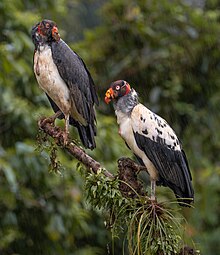
The Accipitridae is one of the three families within the order Accipitriformes, and is a family of small to large birds of prey with strongly hooked bills and variable morphology based on diet. They feed on a range of prey items from insects to medium-sized mammals, with a number feeding on carrion and a few feeding on fruit. The Accipitridae have a cosmopolitan distribution, being found on all the world's continents and a number of oceanic island groups. Some species are migratory. The family contains 255 species which are divided into 70 genera.
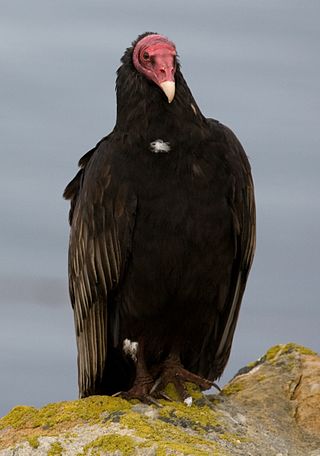
Cathartidae, known commonly as New World vultures or condors, are a family of birds of prey consisting of seven extant species in five genera. It includes five extant vultures and two extant condors found in warm and temperate areas of the Americas. They are known as "New World" vultures to distinguish them from Old World vultures, with which the Cathartidae does not form a single clade despite the two being similar in appearance and behavior as a result of convergent evolution.

The woodcocks are a group of seven or eight very similar living species of wading birds in the genus Scolopax. The genus name is Latin for a snipe or woodcock, and until around 1800 was used to refer to a variety of waders. The English name is first recorded in about 1050. According to the Harleian Miscellany, a group of woodcocks is called a "fall".

The Tyranni (suboscines) are a suborder of passerine birds that includes more than 1,000 species, the large majority of which are South American. It is named after the type genus Tyrannus. These have a different anatomy of the syrinx musculature than the oscines, hence the common name of suboscines.

The king vulture is a large bird found in Central and South America. It is a member of the New World vulture family Cathartidae. This vulture lives predominantly in tropical lowland forests stretching from southern Mexico to northern Argentina. It is the only surviving member of the genus Sarcoramphus, although fossil members are known.

Gyps is a genus of Old World vultures that was proposed by Marie Jules César Savigny in 1809. Its members are sometimes known as griffon vultures. Gyps vultures have a slim head, a long slender neck with downy feathers, and a ruff around the neck formed by long buoyant feathers. The crown of their big beaks is a little compressed, and their big dark nostrils are set transverse to the beak. They have six or seven wing feathers, of which the first is the shortest and the fourth the longest.

The black geese of the genus Branta are waterfowl belonging to the true geese and swans subfamily Anserinae. They occur in the northern coastal regions of the Palearctic and all over North America, migrating to more southerly coasts in winter, and as resident birds in the Hawaiian Islands. Alone in the Southern Hemisphere, a self-sustaining feral population derived from introduced Canada geese is also found in New Zealand.
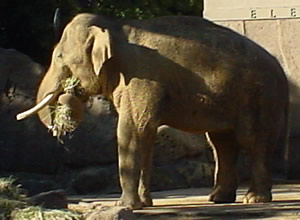
Elephas is one of two surviving genera in the family of elephants, Elephantidae, with one surviving species, the Asian elephant, Elephas maximus. Several extinct species have been identified as belonging to the genus, extending back to the Pliocene era.
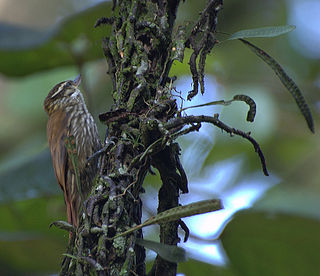
Xenops is a genus in the bird family Furnariidae, the ovenbirds. The genus comprises four species of xenops, all of which are found in Mexico, Central America and South America, particularly in tropical rain forests.

Cancer is a genus of marine crabs in the family Cancridae. It includes eight extant species and three extinct species, including familiar crabs of the littoral zone, such as the European edible crab, the Jonah crab and the red rock crab. It is thought to have evolved from related genera in the Pacific Ocean in the Miocene.

Sisoridae is a family of catfishes. These Asian catfishes live in fast-moving waters and often have adaptations that allow them to adhere to objects in their habitats. The family includes about 235 species.
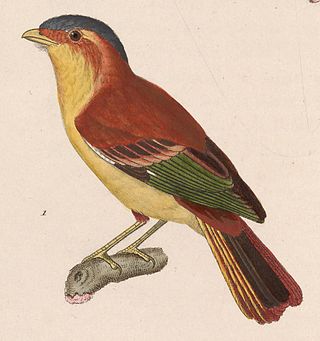
Piprites is a genus of bird currently placed in the family Tyrannidae. Prior to 1971, the genus was placed in the family Pipridae; its designation was initially changed based on morphological evidence, and genetic evidence confirmed its placement in 2009. In 2013, it was proposed that Piprites was to be placed in the unique family Pipritinae. The proposition was declined by the Comité de Clasificación de Sudamérica, a part of the American Ornithological Society, and the proposed family was changed to be a unique subfamily of the genus. The genus is composed of three species native to the neotropical realm, with distributions ranging from the Caribbean coast of Guatemala, Central America, and southeastern Argentina.

Elseya is a genus of large side-necked turtles, commonly known as Australian snapping turtles, in the family Chelidae. Species in the genus Elseya are found in river systems in northern and northeastern Australia and throughout the river systems of New Guinea. They are identified by the presence of alveolar ridges on the triturating surfaces of the mouth and the presence of a complex bridge strut.
The Kern brook lamprey is a species of lamprey in the Petromyzontidae family endemic to the United States. It is found on the east side of San Joaquin Valley, in lower Merced, Kaweah, Kings, and San Joaquin rivers in California. It can grow to up to around 14 centimeters, and is characterized by its grayish brown and white coloring, and black spots on its fins.

Tyrannides is a clade of passerine birds that are endemic to the Americas. The group likely originated in South America during the Eocene, about 45 million years ago.

Parietobalaena is an extinct genus of baleen whale, belonging to the family Pelocetidae. Fossils are found in Miocene-aged marine strata in North America, Europe, Australia, and Japan, including the Temblor and Itahashi formations. Based on previous estimates of juvenile specimens, Tsai (2017) suggested a body size of 12-15 m for P. yamaokai, akin to that of the gray whale.

Neophrontops is an extinct genus of Old World vulture. Despite being taxonomically an "Old World" vulture, specifically a member of the subfamily Gypaetinae, it was native to North America, with six species having been named, spanning from the Early Miocene to the Late Pleistocene. All except N. americanus are only known from fragmentary remains, though well preserved remains are known from the late Middle-Late Pleistocene aged La Brea Tar Pits of Southern California.

Acizzia solanicola is a psyllid from Australia, found on plants of the genus Solanum. It has subsequently been found also in New Zealand.
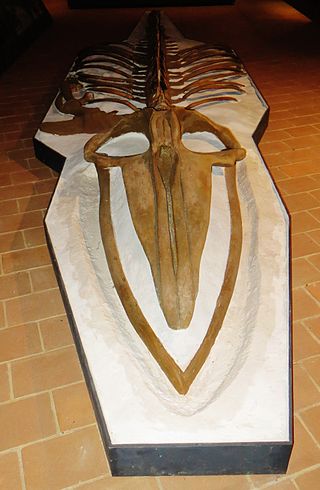
Protororqualus is a genus of extinct rorqual from the late Pliocene of Mount Pulgnasco, Italy.
Peripolocetus is a genus of balaenid baleen whale from the middle Miocene of Kern County, California.
